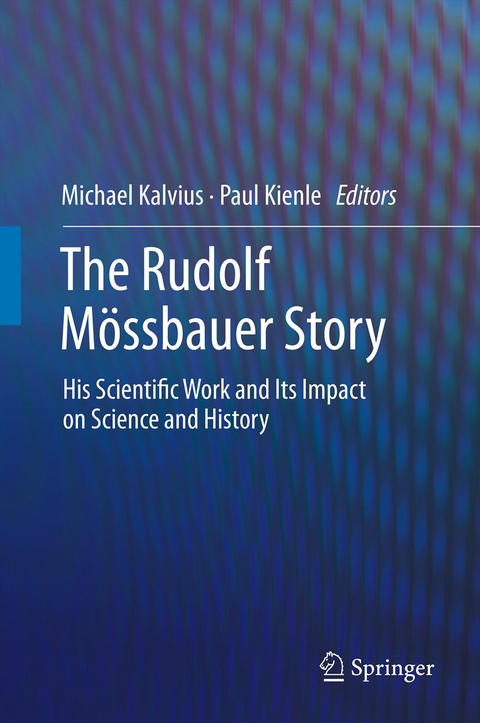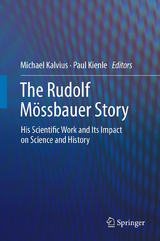The Rudolf Mössbauer Story
Springer Berlin (Verlag)
978-3-642-17951-8 (ISBN)
The "Rudolf Mössbauer Story" recounts the history of the discovery of the "Mössbauer Effect" in 1958 by Rudolf Mössbauer as a graduate student of Heinz Maier-Leibnitz for which he received the Nobel Prize in 1961 when he was 32 years old. The development of numerous applications of the Mössbauer Effect in many fields of sciences , such as physics, chemistry, biology and medicine is reviewed by experts who contributed to this wide spread research. In 1978 Mössbauer focused his research interest on a new field "Neutrino Oscillations" and later on the study of the properties of the neutrinos emitted by the sun.
Prof. Dr.-Ing. Paul Kienle war von 2002 - 2004 Direktor des Stefan-Meyer-Instituts für subatomare Physik der Österreichischen Akademie der Wissenschaften, Wien. Frühere Stationen seiner Laufbahn: Inhaber des Lehrstuhls für Strahlen und Kernphysik an der TH Darmstadt (1963-65), anschließend Professor für Experimentalphysik an der TU München bis zur Emeritierung (1999). Aufbau des Beschleunigerlaboratoriums der LMU und TU München mit Ulrich Meyer Berkhout (1965-71). Als Direktor der GSI Darmstadt Ausbau der Beschleuniger mit einem Synchrotron und Speicherring für schwere Ionen (1984-92). Humboldt-Preis der Republik Frankreich und Forschungspreis der Japan Society for the Promotion of Science. Wissenschaftliche Veröffentlichungen auf dem Gebiet der Kern- und Teilchenphysik, Lehrbücher der Physik und andere wissenschaftliche Bücher.
How the Mössbauer Story started in Munich.- Discovery of the Mössbauer-Effect and its Early History.- Discovery of the Recoil Free Resonance Absorption of Gamma-Rays.- The Iridium and Early Iron Age.- Identification of Hyperfine Interactions in the Mössbauer Spectra.- Other Important Mössbauer Transitions.- CALTECH Years of Rudolf Mössbauer.- Selected Highlights of Mössbauer Spectroscopy.- Determination of the Nuclear Parameters of Many Mössbauer-Transitions.- Isomer Shifts in Solid State Chemistry.- Internal Fields.- Time-Dependent Effect.- Medical and Biological Applications.- Relativistic Effects.- Mössbauer Effect with Synchrotron Radiation.- Outlook.- Mössbauer Effect with Neutrinos.- Dreams with Synchrotron Radiation.- Neutrino Oscillations - The Second Love of Mössbauer.- The "Second Mössbauer Effect".
| Erscheint lt. Verlag | 14.1.2012 |
|---|---|
| Zusatzinfo | XXIV, 436 p. |
| Verlagsort | Berlin |
| Sprache | englisch |
| Maße | 155 x 235 mm |
| Gewicht | 811 g |
| Themenwelt | Sachbuch/Ratgeber ► Natur / Technik |
| Naturwissenschaften ► Chemie ► Analytische Chemie | |
| Naturwissenschaften ► Chemie ► Physikalische Chemie | |
| Naturwissenschaften ► Physik / Astronomie ► Atom- / Kern- / Molekularphysik | |
| Naturwissenschaften ► Physik / Astronomie ► Festkörperphysik | |
| Schlagworte | History of a Nobel laureate • Hyperfine Interactions in the Moessbauer Spectra • isomer shifts in solid state chemistry • medical and biology applications of the Moessbauer • medical and biology applications of the Moessbauer effect • Moessbauer-Effect • Moessbauer effect with neutrinos • Moessbauer effect with synchrotron radiation • Mössbauer, Rudolf • Mössbauer Transitions • nuclear parameters of many Moessbauer-transitions • Recoil Free Resonance Absorption of Gamma-Rays • time dependant Moessbauer effect |
| ISBN-10 | 3-642-17951-7 / 3642179517 |
| ISBN-13 | 978-3-642-17951-8 / 9783642179518 |
| Zustand | Neuware |
| Haben Sie eine Frage zum Produkt? |
aus dem Bereich




